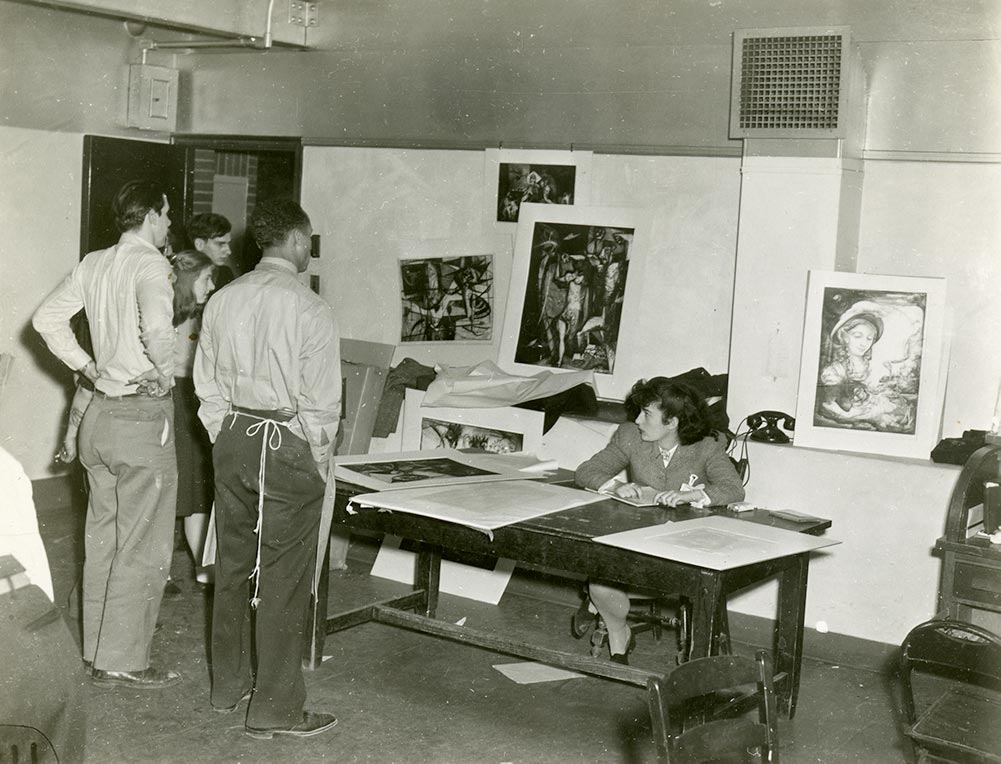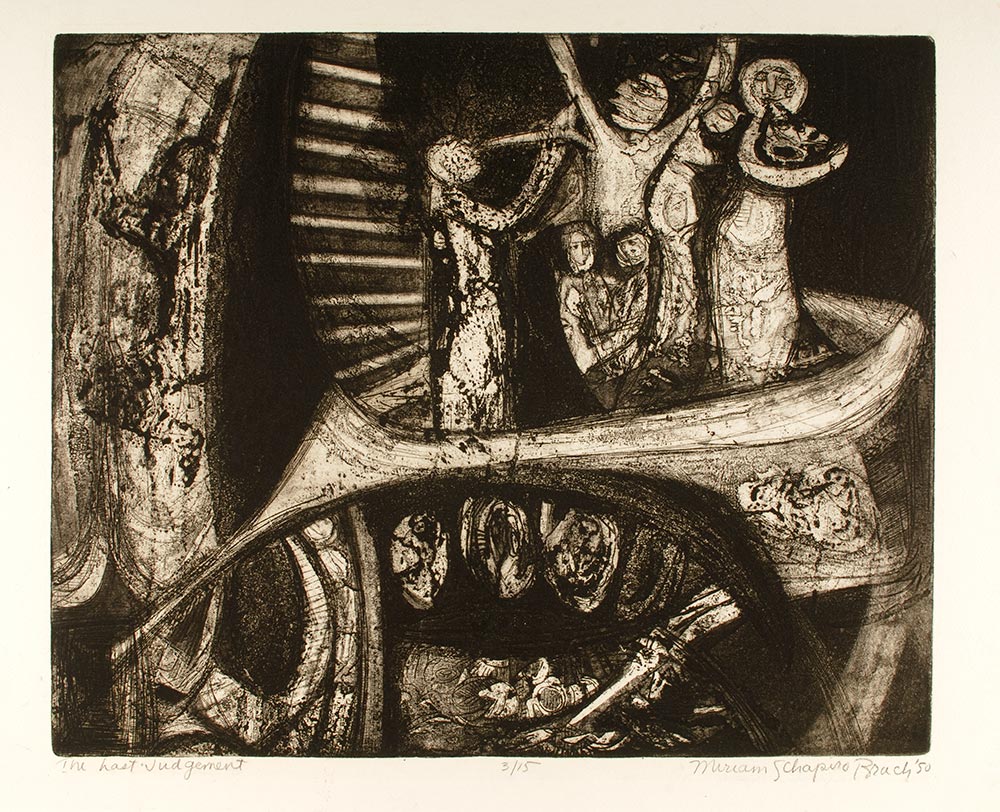82. Miriam Schapiro
| Life Dates | 1923-2015 |
| Place of Birth | Toronto, Canada |
| Place of Death | Hampton Bays, NY, USA |
| Birth Name | Miriam Schapiro |
Influential feminist artist Miriam Schapiro had early and important engagement with midcentury printmaking. Born in Toronto, Canada, but raised in Brooklyn, New York, she enrolled in 1943 in the art program at Hunter College and transferred after one year to the University of Iowa, where she earned several degrees (BA, 1945; MA, 1946; and MFA, 1949). Toward the end of her time at Iowa, Schapiro held an assistantship with Mauricio Lasansky, the Argentinean-born Atelier 17 alumnus who established Iowa’s printmaking program, and she helped to organize the Iowa Print Group. During the summer of 1950, Schapiro and her husband Paul Brach lived in New York City’s West Village, where they sublet Isamu Noguchi’s studio on MacDougal Alley, which he had vacated as the building was slated for demolition.1 Both Schapiro and Brach worked at Atelier 17 that summer, and they returned subsequently in 1951 once the couple relocated to New York City, living at 51 West Tenth Street, which was only a short walk away from Atelier 17’s location on East Eighth Street.2 She actively entered her prints—mostly intaglio with a few woodcuts—into group shows during the late 1940s, exhibiting in the first, third, and fifth Brooklyn Museum print annuals, along with annuals in several other American cities. Prints also factored prominently in her first solo exhibition at Illinois Wesleyan University in 1951.3 Interestingly, not much has been published about Schapiro’s early activity in printmaking, despite the fact that it clearly allowed her to build a network of similarly independent-minded women artists. She also continued to make prints throughout her career, including the beautiful Anonymous Was a Woman portfolio.4
- Biographical entry revised February 2021
Archives
Miriam Schapiro Papers, Rutgers University Archives, New Brunswick, N.J.
Selected Bibliography
“Art Exhibit Opens Sunday at Wesleyan.” The Pantagraph. March 4, 1951.
Beye, Holly. 120 Charles Street, The Village: Journals & Writings, 1949-1950. Huron, Ohio: Bottom Dog Press, 2006.
Derrickson, Howard. “Art and Artists: Museum’s New Prize Print.” St. Louis Post-Dispatch, January 1, 1950.
Gouma-Peterson, Thalia, ed. Miriam Schapiro, A Retrospective, 1953-1980. Wooster, Ohio: The College of Wooster, 1980.
———. Miriam Schapiro: Shaping the Fragments of Art and Life. New York: Harry N. Abrams, in association with the Polk Museum of Art, 1999.
Yassin, Robert A. Miriam Schapiro: Works on Paper, a Thirty Year Retrospective. Edited by Paul Brach. Tucson: Tucson Museum of Art, 1998.
Notes
- The journals of Holly Beye, poet and wife of artist David Ruff who was a dedicated member of Atelier 17, are dotted with social contact with the Brachs during the summer of 1950 and discussion of the couple’s efforts at Atelier 17. Holly Beye, 120 Charles Street, The Village: Journals and Writings, 1949-1950, Huron, Ohio: Bottom Dog Press, 2006: 174, 182, 183-84, 193, 199, 206, 209. ↩
- Rachel Rosenthal remembered meeting Schapiro at Atelier 17. Rachel Rosenthal, oral history by Moira Roth, September 2, 1989, AAA/SI. The timing of Schapiro/Brach’s move to New York is given as either 1951 or 1952. The couple most likely moved in fall 1951, after Brach’s teaching appointment ended at the University of Missouri–Columbia. Complicating the timeline, however, a review of Schapiro’s solo exhibition at Illinois Wesleyan stated she had “studied printmaking under Mauricio Lasansky. Later, she continued study in this field in New York City under Stanley Hayter at his Atelier 17”; “Art Exhibit Opens Sunday at Wesleyan,” 6. ↩
- See group show chronology in Thalia Gouma-Peterson, Miriam Schapiro: Shaping the Fragments of Art and Life (New York: Harry N. Abrams, 1999), 157. Notice of her solo exhibition can be found in “Art Exhibit Opens Sunday at Wesleyan,” Pantagraph, March 4, 1951, 6. Judy Brodsky, Schapiro’s friend and estate’s executor, shared images of early prints from the artist’s studio, email to Christina Weyl, June 1 and 2, 2017. ↩
- Robert A. Yassin, Miriam Schapiro: Works on Paper, a Thirty Year Retrospective, ed. Paul Brach (Tucson: Tucson Museum of Art, 1998). ↩

